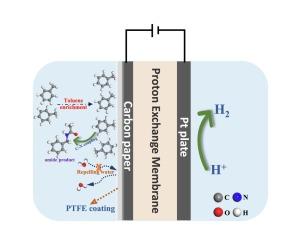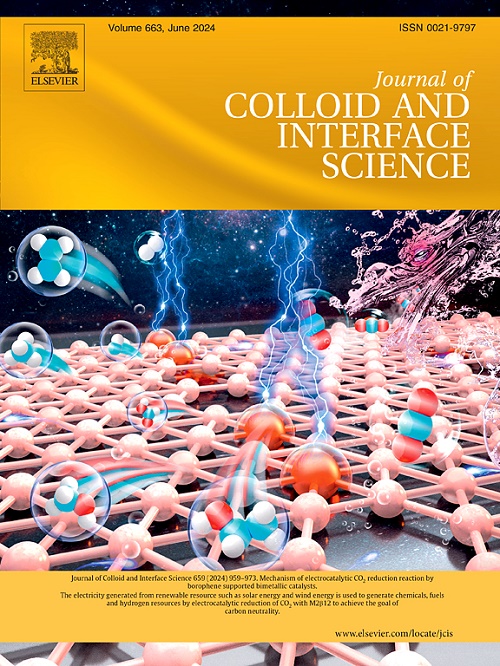通过定制的界面微环境增强甲苯的电催化 CH amination。
IF 9.4
1区 化学
Q1 CHEMISTRY, PHYSICAL
引用次数: 0
摘要
电催化碳氢化合物的 CH amination 是合成高价值 CN 化合物的一个前景广阔的途径。然而,CH 键的高效活化仍然是电催化 CN 偶联的一个重大挑战。在此,我们提出了一种新策略,通过使用聚四氟乙烯(PTFE)涂层碳纸(CP)设计疏水性电极-电解质界面,通过里特式反应提高甲苯到 N-苄基乙酰胺的电催化转化。与纯碳纸(41.5%)相比,疏水性碳纸电极的 N-苄基乙酰胺生产率高达 1860.9 mmol m-2h-1,法拉第效率(FE)大幅提高至 70.1%。实验结果和密度泛函理论(DFT)计算显示,聚四氟乙烯涂层促进了甲苯的吸附,并有效降低了甲苯脱氢的能障。此外,疏水界面还能有效阻碍电极上的水吸附,抑制竞争性水氧化反应。这项研究强调了界面工程在优化电催化 CN 偶联反应以可持续合成高价值酰胺化合物中的关键作用。本文章由计算机程序翻译,如有差异,请以英文原文为准。

Enhanced electrocatalytic CH amination of toluene via tailored interfacial microenvironment
Electrocatalytic C![]() H amination of hydrocarbons is a promising avenue for the synthesis of high-value C
H amination of hydrocarbons is a promising avenue for the synthesis of high-value C![]() N compounds. However, efficient activation of C
N compounds. However, efficient activation of C![]() H bonds remains a significant challenge in electrocatalytic C
H bonds remains a significant challenge in electrocatalytic C![]() N coupling. Herein, we present a novel strategy to enhance the electrocatalytic conversion of toluene to N-benzylacetamide through a Ritter–type reaction by engineering a hydrophobic electrode–electrolyte interface using polytetrafluoroethylene (PTFE)-coated carbon paper (CP). The hydrophobic CP-based electrode exhibited a superior N-benzylacetamide productivity of 1860.9 mmol m−2h−1 and a substantially higher Faradaic efficiency (FE) of 70.1 % compared to pure CP (41.5 %). Experimental results and density functional theory (DFT) calculations reveal that the PTFE coating promotes toluene adsorption and efficiently lowers the energy barrier for toluene dehydrogenation. Additionally, the hydrophobic interface effectively hinders water adsorption on the electrode, suppressing the competitive water oxidation reaction. This study underscores the crucial role of interfacial engineering in optimizing electrocatalytic C
N coupling. Herein, we present a novel strategy to enhance the electrocatalytic conversion of toluene to N-benzylacetamide through a Ritter–type reaction by engineering a hydrophobic electrode–electrolyte interface using polytetrafluoroethylene (PTFE)-coated carbon paper (CP). The hydrophobic CP-based electrode exhibited a superior N-benzylacetamide productivity of 1860.9 mmol m−2h−1 and a substantially higher Faradaic efficiency (FE) of 70.1 % compared to pure CP (41.5 %). Experimental results and density functional theory (DFT) calculations reveal that the PTFE coating promotes toluene adsorption and efficiently lowers the energy barrier for toluene dehydrogenation. Additionally, the hydrophobic interface effectively hinders water adsorption on the electrode, suppressing the competitive water oxidation reaction. This study underscores the crucial role of interfacial engineering in optimizing electrocatalytic C![]() N coupling reactions for the sustainable synthesis of high-value amide compounds.
N coupling reactions for the sustainable synthesis of high-value amide compounds.
求助全文
通过发布文献求助,成功后即可免费获取论文全文。
去求助
来源期刊
CiteScore
16.10
自引率
7.10%
发文量
2568
审稿时长
2 months
期刊介绍:
The Journal of Colloid and Interface Science publishes original research findings on the fundamental principles of colloid and interface science, as well as innovative applications in various fields. The criteria for publication include impact, quality, novelty, and originality.
Emphasis:
The journal emphasizes fundamental scientific innovation within the following categories:
A.Colloidal Materials and Nanomaterials
B.Soft Colloidal and Self-Assembly Systems
C.Adsorption, Catalysis, and Electrochemistry
D.Interfacial Processes, Capillarity, and Wetting
E.Biomaterials and Nanomedicine
F.Energy Conversion and Storage, and Environmental Technologies

 求助内容:
求助内容: 应助结果提醒方式:
应助结果提醒方式:


